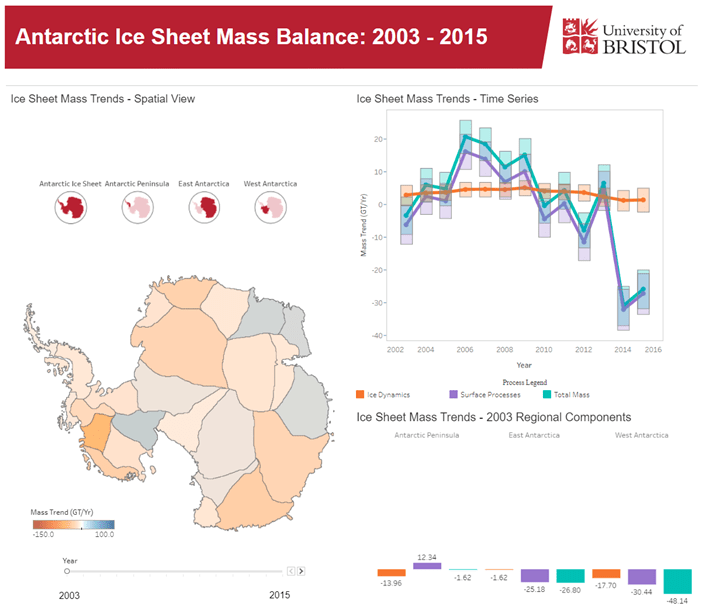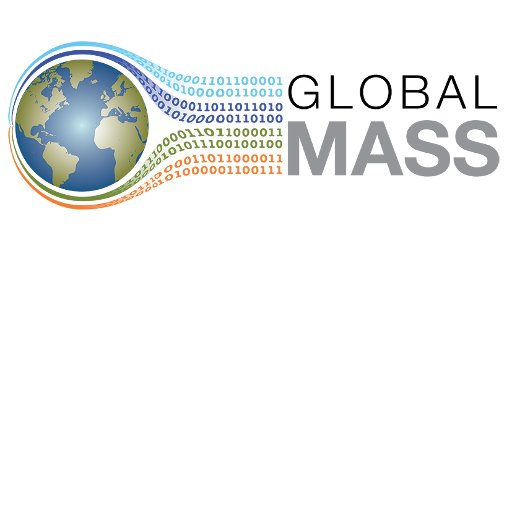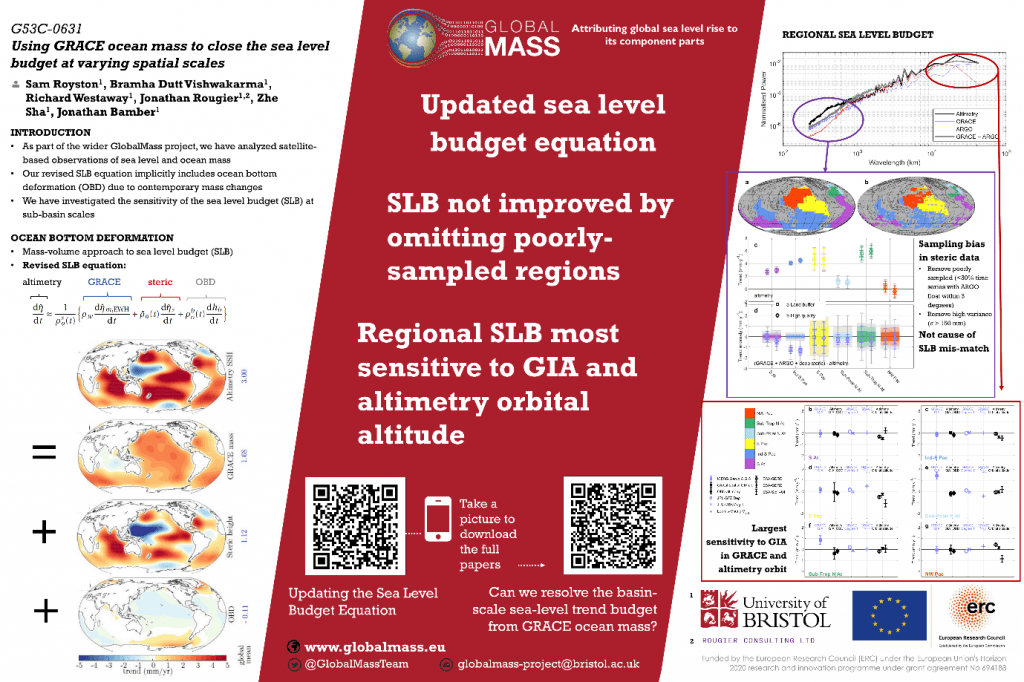As we approach the end of 2019, it seems an appropriate time to reflect on the progress we have made over the last year:
(1) Using satellite-based observations to study the sea level budget at different spatial scales
(2) Investigating ice mass trends for the Antarctic Peninsula using a BHM approach
(3) Investigation of GIA and mass trends for North America
(4) New projections of future sea-level rise based on expert judgment
Published papers and other outputs
(1) Using satellite-based observations to study the sea level budget at different spatial scales
Many of the research activities we have undertaken during 2019 can be grouped together as analyses of satellite-based observations of sea level and ocean mass linked to the global sea level budget.
The global sea level budget is a ‘balance-sheet’ approach for identifying and correctly accounting for all the factors that contribute to sea level rise and provides an important check on the accuracy of observational datasets. In practice it involves comparing measured ‘total’ change in sea surface height change (derived from satellite radar altimetry) with the sum of its component parts, namely measured changes in ocean density (from the network of Argo floats) and ocean mass (from the Gravity Recovery and Climate Experiment, or GRACE, satellite mission).
With over 11 years of very-high quality density and mass observations at good spatial scale, the sum of the parts approaches the total within known uncertainty at a global scale. We have shown, however, that if we examine the sea-level budget at the ocean basin scale, we find significant discrepancies that are difficult to explain, and which persist despite different processing and averaging methods. Specifically, we have found that ocean density measurements do not seem to include small spatial scales that sea surface height measurements do record. Rather than this mismatch averaging out over larger spatial scales, which we expect if the errors are random, it leads to differences in ocean basin averages. We have also uncovered a mismatch at the hemispheric scale, which we believe comes from the way the satellite measurements are processed.
In parallel to these analyses, we have also been working to update and improve the sea level budget equation itself. The conventional sea level budget equation sums mass and density terms but does not include elastic ocean bottom deformation, implicitly assuming it is negligible. However, in recent decades and in large part due to increased ice melt from ice sheets, changes in ocean mass have overtaken density change as a component of sea level rise. Therefore, ocean bottom deformation (OBD) – vertical movement in the ocean floor because of the extra weight of ocean water – can no longer be assumed to be negligible. We have derived a revised sea level budget equation from fundamental physical principles that explicitly includes an OBD term, ensuring that that it is acknowledged as an increasingly important sea level process. We have also tested the revised sea level budget equation with observational data to suggest that OBD is at least as important as deep-ocean volume changes for determining trends in global mean sea level.
Figure 1: Our poster presented at AGU Fall Meeting 2019
Finally, given the known uncertainties associated with ‘direct’ measurements of ocean mass, we have investigated using the global ocean salt budget as an alternative approach. In other words, we have used the observed ‘freshening’ of the global oceans to infer the mass change that must have occurred in order to produce it. This gives an ocean mass trend that is smaller than some other previous estimates, but one which potentially a useful independent validation of trends calculated from GRACE.
Read more:
• Using GRACE ocean mass to close the sea level budget at varying spatial scales (poster presented at American Geophysical Union Fall Meeting 2019, December 2019)
• Can we resolve the basin-scale sea-level trend budget from GRACE ocean mass?
• Updating the Sea Level Budget Equation
(2) Investigating ice mass trends for the Antarctic Peninsula using a BHM approach
A new and significant area of research during 2019 has been the application of a Bayesian Hierarchical Framework (BHM) to investigate ice mass trends for the Antarctic Peninsula. Understanding the mass balance of the Antarctic Peninsula is challenging for satellite-based observation techniques due to its mountainous topography with small outlet glaciers (meaning satellite altimeters lose precision), its geometry (on average 70km wide, significantly less than the 300km resolution of GRACE) and poor knowledge of its ice thickness (which is needed for calculations using the Input-Output Method). As a result, there is a large spread between results obtained from different methods (larger than can be explained by their individual stated errors), with GRACE studies alone suggesting a change in mass balance for the decade 2000 to 2010 that ranges from ~0 to -70 gigatons per year.
Deployment of a BHM framework has allowed us to combine a wide suite of different observational datasets, providing us with an opportunity to reconcile previous studies and to provide greater understanding of regional dynamics. Through the second half of 2019, we have constructed a BHM framework for the Antarctic Peninsula, building on what was done previously in the RATES project by using improved (i.e. higher spatial resolution) and new datasets.
Early results suggest that the different physical processes involved are being separated by the BHM in a sensible way. They also show that the increased spatial resolution of this work (compared to single trend values often provided, or even the relatively-coarse grid used in the RATES project) will likely give us new insight into the ice mass behaviour of the Peninsula.
During 2019, we also launched an online visualisation tool to allow users to interactively explore and download ice mass trend results obtained using our BHM methodology. Initially it contains data on Antarctic mass trends from 2003 to 2015, but we hope to extend the its functionality further to include more outputs from the GlobalMass project.

Figure 2: Our online visualisation tool
Read more:
• Interactive visualisation of Antarctic mass trends from 2003 until present (JGI blog post, July 2019)
(3) Investigation of GIA and mass trends for North America
Following a short pause, and with the additional of Aoibheann Brady and Yann Ziegler to our team, we have resumed development of the BHM framework to explore vertical land motion (VLM) for North America, with the aim of separating the signal into its GIA and mass change components.
The main innovation in our latest work has been a switch to a ‘time-evolving’ solution. Previously, all our deployments of the BHM at a global scale have involved a ‘time-invariant’ approach; that is trends for a given time period represented by a single average value. The time-evolving solution – which we had always intended to move towards as the project progressed – instead considers a time-series of data points. While this means that both data and computational requirements are greater, it should help us separate different sources and will provide us with time-evolving output which should tell us more about the underlying processes that contribute to sea level rise.
We hope to have our first time-evolving output for North America early in 2020.
(4) New projections of future sea-level rise based on expert judgement
Following two workshops held in 2018, we published new projections of sea level rise from future melting of the Greenland, West Antarctic and East Antarctic ice sheets under low and high future global temperature rise scenarios. The potential contribution of ice sheets remains the largest uncertainty in projecting sea level rise beyond 2050 due to limitations in the predictive capability of numerical modelling. We used a technique called structured expert judgement (SEJ) to combine the individual estimates of 22 ice sheet experts. SEJ represents an alternative approach which provides a formal way of estimating uncertain quantities based on current scientific understanding.
Our projections of total global sea level rise include a small but meaningful (5%) probability of SLR exceeding two metres by the year 2100 under the high temperature scenario (roughly equivalent to “business as usual”) which is well above the ‘likely’ upper limit presented in the Fifth Assessment Report of the Intergovernmental Panel on Climate Change (IPCC).
The research has subsequently has been named in this year’s Altmetric Top 100 list, marking it out as one of the most discussed and shared pieces of research published in 2019.
New papers
Bamber JL, Oppenheimer M, Kopp RE, Aspinall WP and Cooke RM (2019). Ice sheet contributions to future sea-level rise from structured expert judgment, PNAS 1817205116 (DOI: 10.1073/pnas.1817205116 ![]() ). Plain language summary available here.
). Plain language summary available here.
Hofer S, Tedstone A, Fettweis X and Bamber JL (2019). Cloud microphysics and circulation anomalies control differences in future Greenland melt, Nature Climate Change 9, 523–528 (DOI: 10.1038/s41558-019-0507-8 ![]() ). Plain language summary available here.
). Plain language summary available here.
Llovel W, Purkey S, Meyssignac B, Blazquez A, Kolodziejczyk N and Bamber JL (2019). Global ocean freshening, ocean mass increase and global mean sea level rise over 2005–2015, Scientific Reports 9, 17717 (DOI: 10.1038/s41598-019-54239-2 ![]() ). Plain language summary available here.
). Plain language summary available here.
Other outputs
Chuter S, Rougier J, Sha Z, Zammit-Mangion A and Bamber JL (2018). Greenland Monthly Mass Trends Determined Using a Bayesian Hierarchical Modelling Approach, Poster at AGU Fall Meeting 2018, Washington DC, 10-14 December 2018.
Bamber JL, Oppenheimer M, Kopp R, Cooke R and Aspinall W (2018). Ice sheet contributions to future sea level rise from a structured expert judgement approach. Poster at AGU Fall Meeting 2018, Washington DC, 10-14 December 2018.
Vishwakarma BD, Bates P, Sneeuw N and Bamber JL (2019). Mapping global water stress from GRACE satellite data. Presentation at Drought and Water Scarcity: addressing current and future challenges, Oxford, 20-21 March 2019.
Chuter S, Rougier J, Zammit-Mangion A and Bamber JL (2019). Greenland Monthly Mass Trends Determined Using a Bayesian Hierarchical Modelling Approach. Poster at EGU 2019, Vienna, Austria, 7-12 April 2019.
Royston S, Vishwakarma BD, Westaway RM and Bamber JL (2019). How Informative is the Basin-Scale Sea-Level Budget? Presentation a EGU 2019, Vienna, Austria, 7-12 April 2019.
Vishwakarma BD, Bates P, Sneeuw N and Bamber JL (2019). Mapping global water stress from GRACE satellite data. Poster at EGU 2019, Vienna, Austria, 7-12 April 2019.
Westaway RM, Vishwakarma BD, Royston S and Bamber JL (2019). A first observation driven estimate of Ocean Bottom Deformation: updating the Sea Level Budget. Presentation at EGU 2019, Vienna, Austria, 7-12 April 2019.
Schumacher M, Sha Z, King M, Rougier J, Khan SA and Bamber JL (2019). A global inverse solution for GIA. Invited talk at EGU 2019, Vienna, Austria, 7-12 April 2019.
Royston S, Vishwakarma BD, Sha Z, Westaway RM, Bamber JL and Rougier J (2019). Robustness of a basin-scale sea level budget. Presentation at ESA Living Planet Symposium, Milan, 13-17 May 2019.
Chuter S, Zammit-Mangion A, Rougier J and Bamber JL (2019). A Bayesian hierarchical model approach to determining Antarctic and Greenland Ice Sheet mass trends from 2003 until present. Presentation at ESA Living Planet Symposium, Milan, 13-17 May 2019.
Royston S, Vishwakarma BD, Westaway RM, Rougier J, Sha Z and Bamber JL (2019). Using GRACE ocean mass to close the sea level budget at varying spatial scales. Poster at AGU Fall Meeting 2019, San Francisco, 9-13 December 2019.
Bamber JL, Oppenheimer M, Kopp RE, Aspinall W and Cooke RM (2019). Interpretation and Analysis of Projected Ice Sheet Contributions from a Structured Expert Judgement. Presentation at AGU Fall Meeting 2019, San Francisco, 9-13 December 2019.


